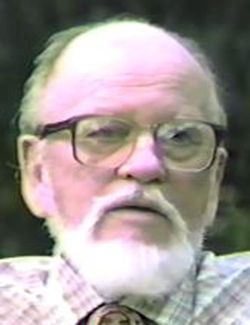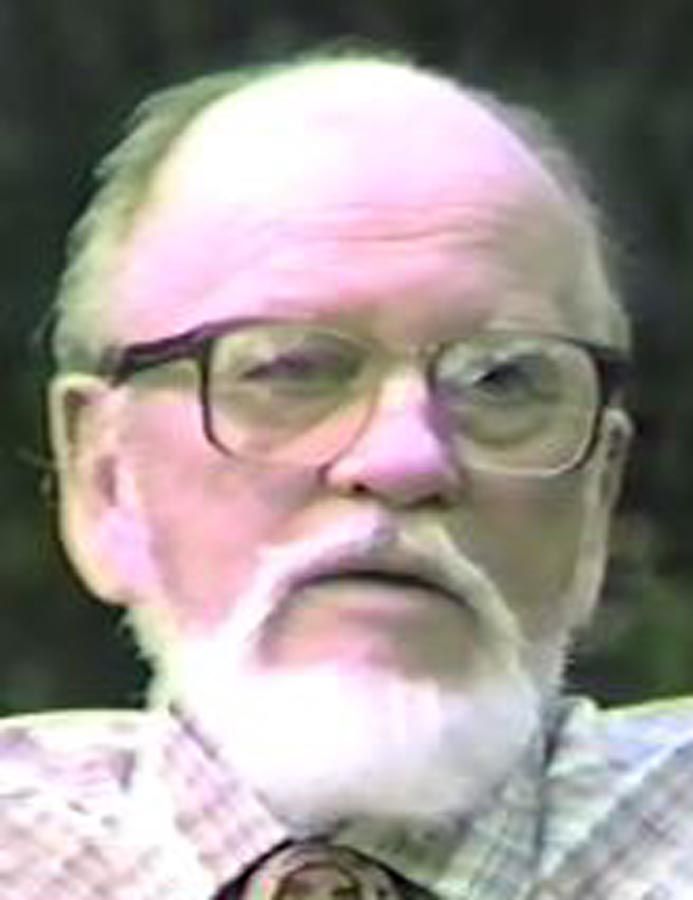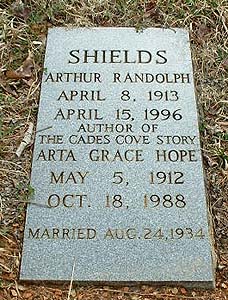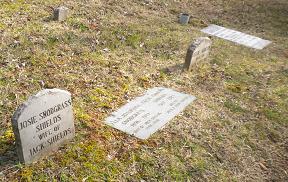During the Second World War, Shields volunteered for service in the Navy Medical Corps. Called to active duty in January of 1944, he was initially assigned to the Sampson, New York, Naval Hospital. In August 1944, he was transferred to the Navy Medical School, Bethesda, Maryland, where he completed a training course in epidemiological medicine and was assigned to a unit in Chicago. He served there until late 1945, when he was discharged as a Hospital Corpsman Second Class.
From the March 28, 2012 edition of The Daily Times of Blount County, Tennessee:
Innovative educator to be honored by UT, Maryville
By Iva Butler
The late biology professor, author and Cades Cove native Arthur Randolph Shields is being honored today by the University of Tennessee and the city of Maryville.
Shields will be inducted into the Educators Hall of Honor at UT and Maryville Mayor Tom Taylor, who was a student of and worked with Shields, declared today as Arthur Randolph Shield Day in Maryville.
Dr. Randy Shields was born April 8, 1913, in Cades Cove, where he lived until the age of 13.
He graduated from Walland High School in 1930, Maryville College in 1934 and received a Master of Science in 1939 and Doctor of Philosophy in 1962 from UT.
"Dr. Shields was a very innovative person for his time," Taylor recalled. "He directed several programs that were really unique."
Shields was the original architect of what is now the Great Smoky Mountains Institute at Tremont.
Shields, Blount County Supervisor of Schools Elsie Burrell, who was getting ready to retire, and Lloyd Foster, a Park ranger at Tremont, were the founders of the natural environment education program at Tremont.
Tremont was a Civilian Conservation Corps (CCC) camp from 1933 to 1942. Then, from 1964 to 1969, it was a Job Corps site.
Then the Blount County group applied to lease the former Job Corps center from the National Park Service under the auspices of Maryville College.
Foster first operated the center and then Shields took over in 1973.
Maryville College leased it almost 10 years, Taylor said. But after the bridges washed out in a flood, Maryville College surrendered the lease to the Great Smoky Mountains National History Association. It then became the Great Smoky Mountains Institute at Tremont under a independent board of directors.
Limnology program
Another innovative program Shields was involved in was the Mid-Appalachian College Conference Inc., which involved a consortium of small colleges in East Tennessee, Kentucky, Virginia and North Carolina, such as Lincoln Memorial University and Emory and Henry College.
The colleges all put money into the program, and Shields directed a research center on Norris Lake each summer.
Faculty members from the various colleges would oversee students doing research.
At that time it was the only undergraduate program in the U.S. that taught limnology (fresh water biology), Taylor said.
Most of the students, who also studied geology and field biology, were from Maryville College.
"We had our own boats, a full lab, research station, and dorms," he said. That lasted eight or nine years until lakeside property got so expensive that some of the colleges wanted to sell because of their economic conditions, Taylor said.
Youth Corps
In 1971 Shields started the Youth Conservation Corps for high school students from all over the state. Based at Tremont, the students would do Park trail work in the summer. Taylor initially was the environmental education director and then became director in the second year of the program. Shields was the Maryville College representative after the college made him chairman of the biology department.
"That was a model corps for the U.S. We had the bulk of the black employees in the Park," Taylor said.
At first all 60 students were boys, but later the program went coed.
"They didn't think girls could do trail work," Taylor said. "However, they went coed and had 30 boys and 30 girls. The girls could do the work.
"The first year I hired Joe and Sue Dawson to be the first coed dorm parents," Taylor said. Joe Dawson recently retired as administrator of Blount Memorial Hospital.
"Shields did all that while teaching full time and serving as chairman of the Maryville College Biology Department," Taylor said.
"He took a sabbatical to write 'The Cades Cove Story' and I taught his courses. Those were really wonderful years teaching at the college," he recalled.
Field trips
Shields also wrote "The Families of Cades Cove, 1921-1936," "Cades Cove Photos: A Pictorial Record of the Place and the People" and "The Descendants of Robert and Margaret Emmert Shields of Cades Cove."
Every other year in December, Shields would take a group of students to the Sonoran Desert. They would spend a week learning the plants of the desert at the Tucson Desert Museum and then spend two weeks camping in the desert.
On opposing years Shields would take a group of students to the University of Miami research facility in the Florida Keys. They would study the coral reefs and ecology. He also took students camping in the Everglades.
They also took multiple trips to Cades Cove, Shields' beloved first home.
He was faculty sponsor of the hiking club at the college.
"The students just loved him," Taylor recalled. "He was gruff and grumpy, but the kids still loved him.
"His method of teaching taught us to think for ourselves," Taylor said. "His real gift was he taught kids how to think. You would not do well in his class if all you did was memorize. You had to think for yourself."
He taught students to do field work and to believe the data they collected, not what they expected the data to show, Taylor added.
During the Second World War, Shields volunteered for service in the Navy Medical Corps. Called to active duty in January of 1944, he was initially assigned to the Sampson, New York, Naval Hospital. In August 1944, he was transferred to the Navy Medical School, Bethesda, Maryland, where he completed a training course in epidemiological medicine and was assigned to a unit in Chicago. He served there until late 1945, when he was discharged as a Hospital Corpsman Second Class.
From the March 28, 2012 edition of The Daily Times of Blount County, Tennessee:
Innovative educator to be honored by UT, Maryville
By Iva Butler
The late biology professor, author and Cades Cove native Arthur Randolph Shields is being honored today by the University of Tennessee and the city of Maryville.
Shields will be inducted into the Educators Hall of Honor at UT and Maryville Mayor Tom Taylor, who was a student of and worked with Shields, declared today as Arthur Randolph Shield Day in Maryville.
Dr. Randy Shields was born April 8, 1913, in Cades Cove, where he lived until the age of 13.
He graduated from Walland High School in 1930, Maryville College in 1934 and received a Master of Science in 1939 and Doctor of Philosophy in 1962 from UT.
"Dr. Shields was a very innovative person for his time," Taylor recalled. "He directed several programs that were really unique."
Shields was the original architect of what is now the Great Smoky Mountains Institute at Tremont.
Shields, Blount County Supervisor of Schools Elsie Burrell, who was getting ready to retire, and Lloyd Foster, a Park ranger at Tremont, were the founders of the natural environment education program at Tremont.
Tremont was a Civilian Conservation Corps (CCC) camp from 1933 to 1942. Then, from 1964 to 1969, it was a Job Corps site.
Then the Blount County group applied to lease the former Job Corps center from the National Park Service under the auspices of Maryville College.
Foster first operated the center and then Shields took over in 1973.
Maryville College leased it almost 10 years, Taylor said. But after the bridges washed out in a flood, Maryville College surrendered the lease to the Great Smoky Mountains National History Association. It then became the Great Smoky Mountains Institute at Tremont under a independent board of directors.
Limnology program
Another innovative program Shields was involved in was the Mid-Appalachian College Conference Inc., which involved a consortium of small colleges in East Tennessee, Kentucky, Virginia and North Carolina, such as Lincoln Memorial University and Emory and Henry College.
The colleges all put money into the program, and Shields directed a research center on Norris Lake each summer.
Faculty members from the various colleges would oversee students doing research.
At that time it was the only undergraduate program in the U.S. that taught limnology (fresh water biology), Taylor said.
Most of the students, who also studied geology and field biology, were from Maryville College.
"We had our own boats, a full lab, research station, and dorms," he said. That lasted eight or nine years until lakeside property got so expensive that some of the colleges wanted to sell because of their economic conditions, Taylor said.
Youth Corps
In 1971 Shields started the Youth Conservation Corps for high school students from all over the state. Based at Tremont, the students would do Park trail work in the summer. Taylor initially was the environmental education director and then became director in the second year of the program. Shields was the Maryville College representative after the college made him chairman of the biology department.
"That was a model corps for the U.S. We had the bulk of the black employees in the Park," Taylor said.
At first all 60 students were boys, but later the program went coed.
"They didn't think girls could do trail work," Taylor said. "However, they went coed and had 30 boys and 30 girls. The girls could do the work.
"The first year I hired Joe and Sue Dawson to be the first coed dorm parents," Taylor said. Joe Dawson recently retired as administrator of Blount Memorial Hospital.
"Shields did all that while teaching full time and serving as chairman of the Maryville College Biology Department," Taylor said.
"He took a sabbatical to write 'The Cades Cove Story' and I taught his courses. Those were really wonderful years teaching at the college," he recalled.
Field trips
Shields also wrote "The Families of Cades Cove, 1921-1936," "Cades Cove Photos: A Pictorial Record of the Place and the People" and "The Descendants of Robert and Margaret Emmert Shields of Cades Cove."
Every other year in December, Shields would take a group of students to the Sonoran Desert. They would spend a week learning the plants of the desert at the Tucson Desert Museum and then spend two weeks camping in the desert.
On opposing years Shields would take a group of students to the University of Miami research facility in the Florida Keys. They would study the coral reefs and ecology. He also took students camping in the Everglades.
They also took multiple trips to Cades Cove, Shields' beloved first home.
He was faculty sponsor of the hiking club at the college.
"The students just loved him," Taylor recalled. "He was gruff and grumpy, but the kids still loved him.
"His method of teaching taught us to think for ourselves," Taylor said. "His real gift was he taught kids how to think. You would not do well in his class if all you did was memorize. You had to think for yourself."
He taught students to do field work and to believe the data they collected, not what they expected the data to show, Taylor added.









